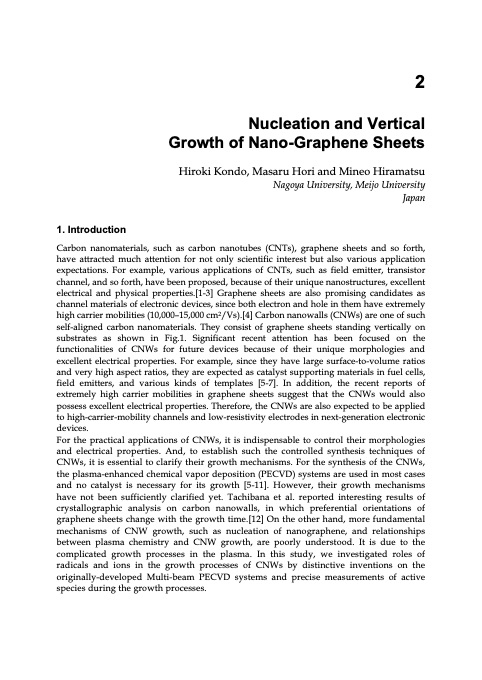PDF Publication Title:
Text from PDF Page: 031
1. Introduction 2 Nucleation and Vertical Growth of Nano-Graphene Sheets Hiroki Kondo, Masaru Hori and Mineo Hiramatsu Nagoya University, Meijo University Japan Carbon nanomaterials, such as carbon nanotubes (CNTs), graphene sheets and so forth, have attracted much attention for not only scientific interest but also various application expectations. For example, various applications of CNTs, such as field emitter, transistor channel, and so forth, have been proposed, because of their unique nanostructures, excellent electrical and physical properties.[1-3] Graphene sheets are also promising candidates as channel materials of electronic devices, since both electron and hole in them have extremely high carrier mobilities (10,000–15,000 cm2/Vs).[4] Carbon nanowalls (CNWs) are one of such self-aligned carbon nanomaterials. They consist of graphene sheets standing vertically on substrates as shown in Fig.1. Significant recent attention has been focused on the functionalities of CNWs for future devices because of their unique morphologies and excellent electrical properties. For example, since they have large surface-to-volume ratios and very high aspect ratios, they are expected as catalyst supporting materials in fuel cells, field emitters, and various kinds of templates [5-7]. In addition, the recent reports of extremely high carrier mobilities in graphene sheets suggest that the CNWs would also possess excellent electrical properties. Therefore, the CNWs are also expected to be applied to high-carrier-mobility channels and low-resistivity electrodes in next-generation electronic devices. For the practical applications of CNWs, it is indispensable to control their morphologies and electrical properties. And, to establish such the controlled synthesis techniques of CNWs, it is essential to clarify their growth mechanisms. For the synthesis of the CNWs, the plasma-enhanced chemical vapor deposition (PECVD) systems are used in most cases and no catalyst is necessary for its growth [5-11]. However, their growth mechanisms have not been sufficiently clarified yet. Tachibana et al. reported interesting results of crystallographic analysis on carbon nanowalls, in which preferential orientations of graphene sheets change with the growth time.[12] On the other hand, more fundamental mechanisms of CNW growth, such as nucleation of nanographene, and relationships between plasma chemistry and CNW growth, are poorly understood. It is due to the complicated growth processes in the plasma. In this study, we investigated roles of radicals and ions in the growth processes of CNWs by distinctive inventions on the originally-developed Multi-beam PECVD systems and precise measurements of active species during the growth processes.PDF Image | GRAPHENE SYNTHESIS CHARACTERIZATION PROPERTIES

PDF Search Title:
GRAPHENE SYNTHESIS CHARACTERIZATION PROPERTIESOriginal File Name Searched:
Graphene-Synthesis.pdfDIY PDF Search: Google It | Yahoo | Bing
Salgenx Redox Flow Battery Technology: Power up your energy storage game with Salgenx Salt Water Battery. With its advanced technology, the flow battery provides reliable, scalable, and sustainable energy storage for utility-scale projects. Upgrade to a Salgenx flow battery today and take control of your energy future.
CONTACT TEL: 608-238-6001 Email: greg@infinityturbine.com (Standard Web Page)